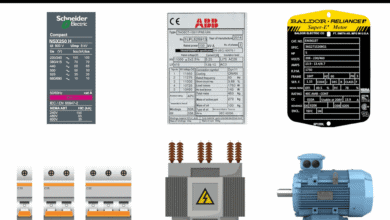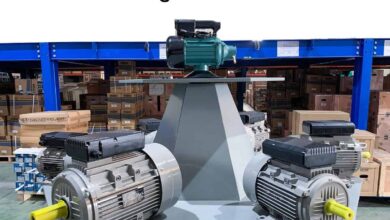Swinburne’s Test of DC Motors & Generators – Circuit, Calculation, Advantages & Applications
What is Swinburne’s Test?
Swinburne’s test (named after James Swinburne) is an indirect method of testing a DC shunt or DC compound motor. During this test, the motor is not loaded. Therefore, this method of testing is also known as No-load Test. The Swinburne’s test is very helpful for very large machines that cannot be tested on actual load. So, this method helps to determine the performance characteristics of large DC machines.
The Swinburne’s test is performed to calculate the losses and efficiency of the motor at any desired load. In this test, the DC machine operates as a motor running on no load. The excitation is given to the motor to operate on rated voltage and rated speed. The connection diagram of the Swinburne’s test is shown in the figure below.
Circuit Diagram
Performance
The connection diagram of the Swinburne’s test for the DC shunt motor is shown in the above figure. Here,
- V = Supply Voltage
- I0 = No-load Current
- ISh = Shunt field Current
In no-load condition, the current flows through the armature are;
Ia0 = I0 – ISh
No-load Input power = V I0
The no-load power is used to supply;
- Iron loss in the core
- Friction loss in commutator and bearings
- Windage loss
- Armature copper loss at no-load
When the machine is loaded, the temperature of the field winding and armature winding is increased. During this test, the resistance of both windings is measured using the voltmeter-ammeter method. And the temperature of a winding is at room temperature (let’s say ). Consider, when the machine is loaded, the temperature rise of winding is approximately 40-50˚ C.
So, we need to add a hot resistance to avoid temperature rise. The hot resistance allows a temperature rise of 40˚ C and the calculation is as follows;
For 40˚ C;
Where, α0 = temperature coefficient of resistance at 0˚ C.
Now, the supply voltage (V) is measured by voltmeter V, motor input current (I0) is measured by ammeter A1, and the shunt field current (Ish) is measured by ammeter A2.
Here, the DC machine operates on a no-load. Hence, we can consider the mechanical loss as zero. And the input power is used to supply internal losses in a machine that includes; Shunt field copper loss, Armature copper loss, and Stray power loss in a shunt wound machine. In the case of a compound wound machine, it also includes series field copper loss.
Input power at no-load = V I0 Watt
Shunt field copper loss = V ISh Watt
From the circuit diagram, the current passes through the armature Ia in the no-load condition is;
Ia0 = I0 – ISh
So, the armature copper loss = I2a0 Ra = (I0 – ISh)2 Ra (where Ra = hot resistance of armature)
Stray power loss, Ps = Input on no-load – Shunt field loss – armature copper loss
Ps = V I0 – V ISh – (I0 – ISh)2 Ra
Constant losses, Pc = Ps + Shunt field copper loss
PC = V I0 – V ISh – (I0 – ISh)2 Ra + V ISh
PC = V I0 – (I0 – ISh)2 Ra
Efficiency Calculation
Efficiency of DC Machine When it is Running as a Motor
Assume;
Load current = IL – Ampere
Load voltage = V – Volt
Total input power = V IL – Watts
Total constant losses are the same as determined above;
Total constant losses = PC = V I0 – (I0 – ISh)2 Ra
Armature copper loss = (I0 – ISh)2 Ra
Total losses = PT = PC + (I0 – ISh)2 Ra = V I0 – (I0 – ISh)2 Ra + (I0 – ISh)2 Ra
Output = Input – PT = V IL – PT
Efficiency of DC Machine When it is Running as a Generator
Let’s assume that, the generator supplies load current Amp at load voltage Volts.
Generator Output = V IL – Watts
Armature copper loss = Ia2 Ra
For generator; Ia = IL + ISh
Therefore, Armature copper loss = (IL + ISh)2 Ra
Constant loss, PC = V I0 – (I0 – ISh)2 Ra
Therefore, Total losses in Generator, = PT = PC + (IL + ISh)2 Ra
PT = V I0 – (I0 – ISh)2 Ra + (IL + ISh)2 Ra
Input = Output + Total Losses
Input = V IL + PT
So, Generator efficiency,
Advantages and Disadvantages of Swinburne Test
Advantages
The advantages of the Swinburne’s test in DC machines are listed below.
- For large-scale machines, it is not possible to arrange a large load to test this machine. As this test is done in no-load condition, it is suitable to perform testing in a laboratory without actual loading.
- It requires less time to perform this test.
- As we have not connected the full load, the input power is required only for losses. Hence, this test does not require much power.
- Losses and efficiency of a machine are calculated for any load condition.
- The energy loss that occurs during this test is very low. And hence, excessive heat is not produced during this test.
- Through this test, DC shunt and compound wound machines are tested.
Disadvantages
The disadvantages of the Swinburne’s test are listed below.
- There is no provision taken for a change in iron loss from no-load to full-load. The iron loss is not the same in both conditions because of the distribution of flux due to the armature reaction. The flux is much affected in full-load condition due to armature reaction. And in some conditions, the extent of iron loss is up to 1.5 times compared to the no-load condition.
- As we are performing this test on no-load, we don’t have information about proper commutation and temperature rise in the full-load condition.
- This test can be performed in a DC series motor. Because the DC series motor will rotate at dangerously high speed on no-load. So, it may damage the motor. And also, this test is suitable for machines in which the flux and speed remain constant. Therefore, this test is only applicable to the DC shunt and compound motors.
Related Posts:
- No-load Test of Induction Motor – Block Rotor Test of Motor
- Polarity Test of a Transformer – Circuit Diagram and Working
- Sumpner’s Test or Back-to-Back Test on a Transformer
- Short Circuit Test and Open Circuit Test of Transformer
- Losses in a DC Generator – Power Stages & Efficiency of DC Generator
- Losses in a DC Motor – Power Stages & Efficiency of DC Motor
- Losses in Synchronous Motor – Power Stages & Efficiency of Synchronous Motors
- Losses in Alternator – Power Stages & Efficiency of Synchronous Generator
- Losses in a Induction Motor – Power Stages in Asynchronous Motor
- Transformer Losses – Different Types of Losses in a Transformer
- Losses in Electrical Machines – Formulas and Equations




 Difference Between Rated Current and Nominal Current
Difference Between Rated Current and Nominal Current Why are 1-Phase Motors Not Self-Starting Like 3-Phase Motors?
Why are 1-Phase Motors Not Self-Starting Like 3-Phase Motors? What is the Main Difference Between FLA and FLC?
What is the Main Difference Between FLA and FLC? Difference Between Direct-On-Line (DOL) and Star Delta Starter
Difference Between Direct-On-Line (DOL) and Star Delta Starter Difference Between NEMA and IEC Motor Starters & Contactors
Difference Between NEMA and IEC Motor Starters & Contactors Part 14 – How to Size Star-Delta Starter for Motors?
Part 14 – How to Size Star-Delta Starter for Motors?